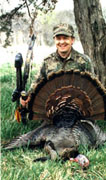Physical Senses and Abilities
Copyright © 1998 -
2021
Roger W. Raisch * Nadine Adele, all rights reserved
|
| Turkeys are tremendous athletes. They can fly 50 miles per hour, and
run up to 35 miles per hour for short distances. Their
flight takes extreme coordination. A turkey's reflexes are remarkable...it can be
standing still and jump into flight and be 40 yards away before a hunter can react to
shoulder his gun. |
| Vision is their primary warning
system. They have large, flat eyes on the sides of
their head. This means that they have superior peripheral vision. Their only
blind spot is a narrow spot directly behind them. For all practical purposes,
however, assume a turkey can see in a 360 degree circle all around them because their head
is almost always moving to detect danger. Because of the location of their eyes, a
turkey's depth perception is not good. They see the world with only one eye at a
time. Objects appear to be flat to a turkey. It's hard for them to pick out
shapes, especially if those shapes blend in well with surrounding vegetation (like a
camouflaged hunter). |
| A turkey's eyes have excellent
focusing power and resolution. They see movement
instantly and identify objects quickly, because if they didn't, they would be unable to
fly down through the trees at 50 mph without getting their necks broken every time.
Imagine a human on a bicycle trying to ride it at 50 mph through the woods...wouldn't get
too far and what a mess to clean up! I think you can
see that they have remarkable eye-body coordination--far superior to a human. |
| Turkeys also see color and
reflections like a human. This is why you need to wear
full camouflage while hunting these sharp-eyed birds. Any out-of-place color like an
uncovered human face or hand, shiny gun barrel, or the like, will instantly put a turkey
on alert. |
| The ears of a turkey are located
just above its eyes. A turkey is good at locating your calling position. It's been said that turkeys have a sense of direction like built-in radar. It may not be quite that good, but I know that just a call or two
to a turkey and it will normally walk within 15 yards of the hunter if it's not alerted
and it wants to come to the source of the sound. |
| The woods is a noisy place and it's
difficult to hear well in certain conditions, even for turkeys. A turkey's hearing is about as good as humans.
A hunter walking in the leaves sometimes sounds just like a turkey walking. I've
moved too close to turkeys when setting up only to have them walk right up to me before I
even made a call. I know they heard me, thought the sound of my walking was another
turkey and came over to investigate. If a turkey hears a strange sound, it Looks for danger, then Runs if it sees something it doesn't like.
Usually if it doesn't see something that frightens it, it will relax after a few
minutes and go back to doing what it was doing. So, as
a hunter if you have to make a mistake, make it an audible mistake, not a visual mistake. If you make a noise, like stepping on a stick that snaps, stop for
a few minutes and let things settle down before proceeding. Make certain that a turkey
doesn't see you or see any movement when you're calling. |
| To summarize, a turkeys have
advantages over humans in that they can spot movement all around them, focus on and
identify any shape that is out of place (you), and run or fly faster than a hunter can
react to shoot. But, the good news is that a turkey has trouble identifying
motionless, neutral-colored objects (like you in camouflage) because they don't have good
depth perception. Finally, don't be too worried about their hearing, but I would encourage you to stalk around the woods as quietly as possible and
not make any human noises....period. |
|
| |
t

God Bless America
|
View
Cart & Check-Out
NOVEMBER
2025
877.267.3877
515.299.5388
24 / 7
WE answer
our
phones Personally!
|
|












